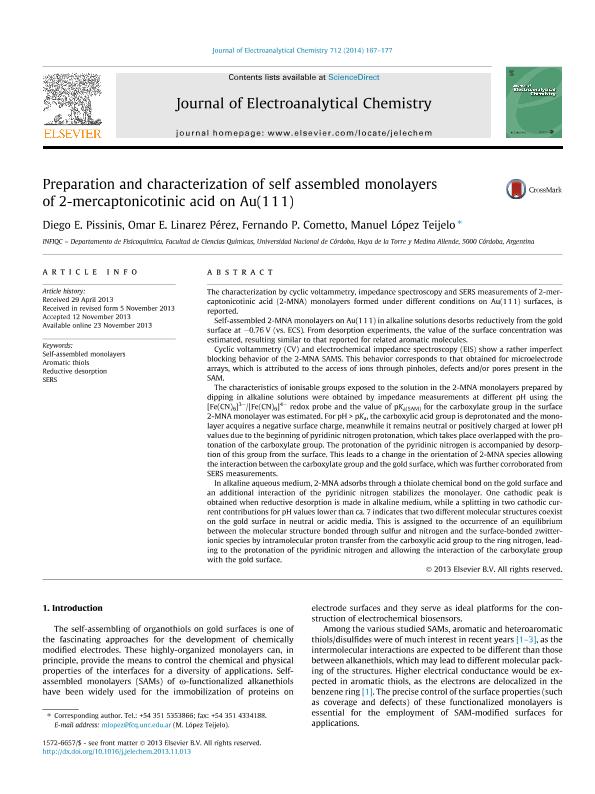Mostrar el registro sencillo del ítem
dc.contributor.author
Pissinis, Diego Ezequiel

dc.contributor.author
Linarez Pérez, Omar Ezequiel

dc.contributor.author
Cometto, Fernando Pablo

dc.contributor.author
Lopez Teijelo, Manuel

dc.date.available
2017-12-26T17:36:31Z
dc.date.issued
2014-01
dc.identifier.citation
Lopez Teijelo, Manuel; Cometto, Fernando Pablo; Linarez Pérez, Omar Ezequiel; Pissinis, Diego Ezequiel; Preparation and characterization of self assembled monolayers of 2-mercaptonicotinic acid on Au(1 1 1); Elsevier Science Sa; Journal of Electroanalytical Chemistry; 712; 1-2014; 167-177
dc.identifier.issn
1572-6657
dc.identifier.uri
http://hdl.handle.net/11336/31538
dc.description.abstract
The characterization by cyclic voltammetry, impedance spectroscopy and SERS measurements of 2-mer-captonicotinic acid (2-MNA) monolayers formed under different conditions on Au(111) surfaces, isreported.Self-assembled 2-MNA monolayers on Au(111) in alkaline solutions desorbs reductively from the goldsurface at 0.76 V (vs. ECS). From desorption experiments, the value of the surface concentration wasestimated, resulting similar to that reported for related aromatic molecules.Cyclic voltammetry (CV) and electrochemical impedance spectroscopy (EIS) show a rather imperfectblocking behavior of the 2-MNA SAMS. This behavior corresponds to that obtained for microelectrodearrays, which is attributed to the access of ions through pinholes, defects and/or pores present in theSAM.The characteristics of ionisable groups exposed to the solution in the 2-MNA monolayers prepared bydipping in alkaline solutions were obtained by impedance measurements at different pH using the[Fe(CN)6]3 /[Fe(CN)6]4 redox probe and the value of pKa(SAM)for the carboxylate group in the surface2-MNA monolayer was estimated. For pH > pKa, the carboxylic acid group is deprotonated and the mono-layer acquires a negative surface charge, meanwhile it remains neutral or positively charged at lower pHvalues due to the beginning of pyridinic nitrogen protonation, which takes place overlapped with the pro-tonation of the carboxylate group. The protonation of the pyridinic nitrogen is accompanied by desorp-tion of this group from the surface. This leads to a change in the orientation of 2-MNA species allowingthe interaction between the carboxylate group and the gold surface, which was further corroborated fromSERS measurements.In alkaline aqueous medium, 2-MNA adsorbs through a thiolate chemical bond on the gold surface andan additional interaction of the pyridinic nitrogen stabilizes the monolayer. One cathodic peak isobtained when reductive desorption is made in alkaline medium, while a splitting in two cathodic cur-rent contributions for pH values lower than ca. 7 indicates that two different molecular structures coexiston the gold surface in neutral or acidic media. This is assigned to the occurrence of an equilibriumbetween the molecular structure bonded through sulfur and nitrogen and the surface-bonded zwitter-ionic species by intramolecular proton transfer from the carboxylic acid group to the ring nitrogen, lead-ing to the protonation of the pyridinic nitrogen and allowing the interaction of the carboxylate groupwith the gold surface.
dc.format
application/pdf
dc.language.iso
eng
dc.publisher
Elsevier Science Sa

dc.rights
info:eu-repo/semantics/openAccess
dc.rights.uri
https://creativecommons.org/licenses/by-nc-sa/2.5/ar/
dc.subject
Self Assembled Monolayers
dc.subject
Aromatic Thiols
dc.subject
Reductive Desorption
dc.subject
Sers
dc.subject.classification
Otras Ciencias Químicas

dc.subject.classification
Ciencias Químicas

dc.subject.classification
CIENCIAS NATURALES Y EXACTAS

dc.title
Preparation and characterization of self assembled monolayers of 2-mercaptonicotinic acid on Au(1 1 1)
dc.type
info:eu-repo/semantics/article
dc.type
info:ar-repo/semantics/artículo
dc.type
info:eu-repo/semantics/publishedVersion
dc.date.updated
2017-12-21T16:29:49Z
dc.journal.volume
712
dc.journal.pagination
167-177
dc.journal.pais
Países Bajos

dc.journal.ciudad
Amsterdam
dc.description.fil
Fil: Pissinis, Diego Ezequiel. Consejo Nacional de Investigaciones Científicas y Técnicas. Centro Científico Tecnológico Conicet - Córdoba. Instituto de Investigaciones en Físico-química de Córdoba. Universidad Nacional de Córdoba. Facultad de Ciencias Químicas. Instituto de Investigaciones en Físico-química de Córdoba; Argentina
dc.description.fil
Fil: Linarez Pérez, Omar Ezequiel. Consejo Nacional de Investigaciones Científicas y Técnicas. Centro Científico Tecnológico Conicet - Córdoba. Instituto de Investigaciones en Físico-química de Córdoba. Universidad Nacional de Córdoba. Facultad de Ciencias Químicas. Instituto de Investigaciones en Físico-química de Córdoba; Argentina
dc.description.fil
Fil: Cometto, Fernando Pablo. Consejo Nacional de Investigaciones Científicas y Técnicas. Centro Científico Tecnológico Conicet - Córdoba. Instituto de Investigaciones en Físico-química de Córdoba. Universidad Nacional de Córdoba. Facultad de Ciencias Químicas. Instituto de Investigaciones en Físico-química de Córdoba; Argentina
dc.description.fil
Fil: Lopez Teijelo, Manuel. Consejo Nacional de Investigaciones Científicas y Técnicas. Centro Científico Tecnológico Conicet - Córdoba. Instituto de Investigaciones en Físico-química de Córdoba. Universidad Nacional de Córdoba. Facultad de Ciencias Químicas. Instituto de Investigaciones en Físico-química de Córdoba; Argentina
dc.journal.title
Journal of Electroanalytical Chemistry

dc.relation.alternativeid
info:eu-repo/semantics/altIdentifier/doi/http://dx.doi.org/10.1016/j.jelechem.2013.11.013
dc.relation.alternativeid
info:eu-repo/semantics/altIdentifier/url/http://www.sciencedirect.com/science/article/pii/S1572665713005109
Archivos asociados
